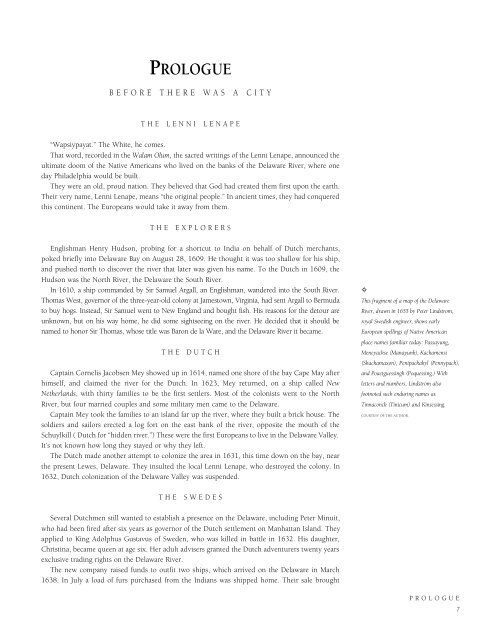Historic Philadelphia
An illustrated history of the city of Philadelphia, paired with the histories of companies, families and organizations that make the region great.
An illustrated history of the city of Philadelphia, paired with the histories of companies, families and organizations that make the region great.
You also want an ePaper? Increase the reach of your titles
YUMPU automatically turns print PDFs into web optimized ePapers that Google loves.
PROLOGUE<br />
BEFORE THERE WAS A CITY<br />
THE LENNI LENAPE<br />
“Wapsiypayat.” The White, he comes.<br />
That word, recorded in the Walam Olum, the sacred writings of the Lenni Lenape, announced the<br />
ultimate doom of the Native Americans who lived on the banks of the Delaware River, where one<br />
day <strong>Philadelphia</strong> would be built.<br />
They were an old, proud nation. They believed that God had created them first upon the earth.<br />
Their very name, Lenni Lenape, means “the original people.” In ancient times, they had conquered<br />
this continent. The Europeans would take it away from them.<br />
THE<br />
EXPLORERS<br />
Englishman Henry Hudson, probing for a shortcut to India on behalf of Dutch merchants,<br />
poked briefly into Delaware Bay on August 28, 1609. He thought it was too shallow for his ship,<br />
and pushed north to discover the river that later was given his name. To the Dutch in 1609, the<br />
Hudson was the North River, the Delaware the South River.<br />
In 1610, a ship commanded by Sir Samuel Argall, an Englishman, wandered into the South River.<br />
Thomas West, governor of the three-year-old colony at Jamestown, Virginia, had sent Argall to Bermuda<br />
to buy hogs. Instead, Sir Samuel went to New England and bought fish. His reasons for the detour are<br />
unknown, but on his way home, he did some sightseeing on the river. He decided that it should be<br />
named to honor Sir Thomas, whose title was Baron de la Ware, and the Delaware River it became.<br />
THE<br />
DUTCH<br />
Captain Cornelis Jacobsen Mey showed up in 1614, named one shore of the bay Cape May after<br />
himself, and claimed the river for the Dutch. In 1623, Mey returned, on a ship called New<br />
Netherlands, with thirty families to be the first settlers. Most of the colonists went to the North<br />
River, but four married couples and some military men came to the Delaware.<br />
Captain Mey took the families to an island far up the river, where they built a brick house. The<br />
soldiers and sailors erected a log fort on the east bank of the river, opposite the mouth of the<br />
Schuylkill ( Dutch for “hidden river.”) These were the first Europeans to live in the Delaware Valley.<br />
It’s not known how long they stayed or why they left.<br />
The Dutch made another attempt to colonize the area in 1631, this time down on the bay, near<br />
the present Lewes, Delaware. They insulted the local Lenni Lenape, who destroyed the colony. In<br />
1632, Dutch colonization of the Delaware Valley was suspended.<br />
✧<br />
This fragment of a map of the Delaware<br />
River, drawn in 1655 by Peter Lindstrom,<br />
royal Swedish engineer, shows early<br />
European spellings of Native American<br />
place names familiar today: Passayung,<br />
Meneyackse (Manayunk), Kackamensi<br />
(Shackamaxon), Penipackakyl (Pennypack),<br />
and Poaetguessingh (Poquessing.) With<br />
letters and numbers, Lindstrom also<br />
footnoted such enduring names as<br />
Tinnaconck (Tinicum) and Kinsessing.<br />
COURTESY OF THE AUTHOR.<br />
THE<br />
SWEDES<br />
Several Dutchmen still wanted to establish a presence on the Delaware, including Peter Minuit,<br />
who had been fired after six years as governor of the Dutch settlement on Manhattan Island. They<br />
applied to King Adolphus Gustavus of Sweden, who was killed in battle in 1632. His daughter,<br />
Christina, became queen at age six. Her adult advisers granted the Dutch adventurers twenty years<br />
exclusive trading rights on the Delaware River.<br />
The new company raised funds to outfit two ships, which arrived on the Delaware in March<br />
1638. In July a load of furs purchased from the Indians was shipped home. Their sale brought<br />
PROLOGUE<br />
7
















